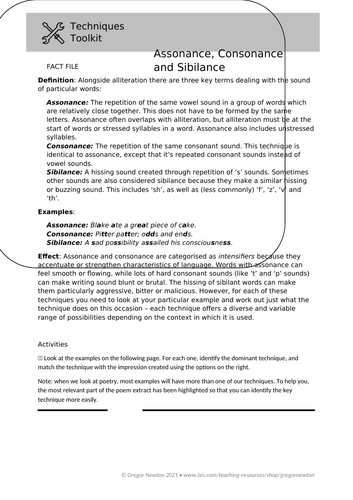



This resource focuses on the language techniques assonance, consonance and sibilance. The worksheet begins with an information box which explains the techniques, gives examples and explains their effect. This is followed by activities which focus on identifying the different techniques in a range of poetry extracts and matching or explaining the effect of each technique on the poem, such as the way they can increase aggression or change the pace of a poem.
The PowerPoint is designed to accompany the worksheet and includes sample answers for a number of the worksheet tasks as well as some extra activities based on the techniques in advertising/branding and tongue twisters.
This resource is suitable for a high school audience. The worksheet is included in both Word and pdf formats to ensure no loss of detail.
This ‘techniques toolkit’ resource is part of a set on language features and techniques in English. Check out these other techniques toolkit resources:
Allusion | Assonance, Consonance, Sibilance | Emotive Language | Euphemism | Focalisation (Point of View) | Iambic Pentameter | Imagery | Irony | Juxtaposition | Metaphor | Modality | Personification | Symbolism | Tone and Mood
Something went wrong, please try again later.
HI I downloaded this but really do not understand it, I cannot see how your examples of consonance are so. Instead they seem to be more examples of alliteration, I am not an English specialist so paid for this resource and yet I cannot understand how hunger of blood; Blue with all malice, are examples of consonance, Please can you explain
Report this resourceto let us know if it violates our terms and conditions.
Our customer service team will review your report and will be in touch.